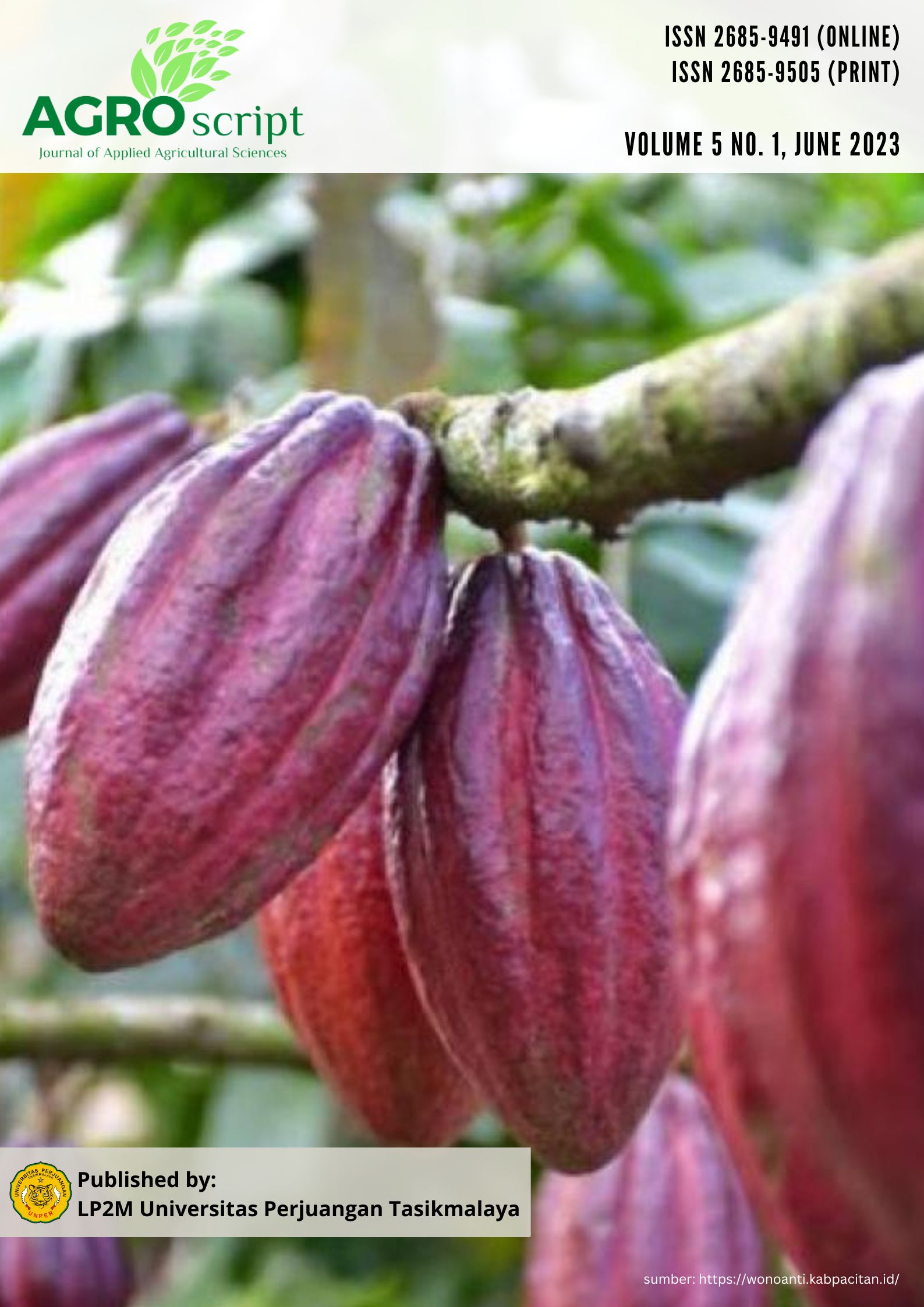Pengaruh Dosis dan Jenis Aplikasi Boron terhadap Tingkat Layu Pentil (Cherelle wilt) Tanaman Kakao
DOI:
https://doi.org/10.36423/agroscript.v5i1.1219Keywords:
Cherelle, Kakao, Boron, Nutrient, FertilizerAbstract
Cherelle wilt merupakan penyakit fisiologis pada tahap awal perkembangan buah kakao karena kegagalan perkembangan buah. Salah satu unsur yang diduga kuat menjadi penyebab adalah unsur boron yang ketersediannya sangat penting bagi tanaman karena berperan dalam perkembangan sel, metabolisme protein, asam amino, nitrat, lemak, karbohidrat, auksin dan fenol, fungsi membran, berperan dalam keberhasilan pembentukan bunga, pembuahan dan perkembangan buah. Tujuan penelitian untuk mengkaji dan meneliti tentang pengaruh boron terhadap layu pentil kakao. Penelitian dirancang menggunakan rancangan Randomized Complete Block Design (RCBD) dimana faktor A terdiri dari metode aplikasi pupuk yaitu lewat daun dan lewat tanah sedangkan faktor B adalah takaran pemberian boron yang terdiri dari tanpa pemberian pupuk , pemberian boron 1,5 g.pohon-1, 3 g. Pohon-1, 4,5 g.pohon-1 dan 6 g.pohon-1 setiap perlakuan diulang tiga kali, setiap ulangan terdiri dari 5 tanaman sehingga kombinasi perlakuan menjadi 2 x 5 x 3 x 5 = 150 tanaman. Parameter yang diamati adalah Boron total daun, viabilitas pollen, total pentil yang terbentuk, persentase pentil sehat, dan pentil layu. Hasil menunjukkan bahwa metode aplikasi pupuk boron berpengaruh terhadap layu pentil kakao. Metode aplikasi boron lewat daun dengan dosis 0, 4,5 dan 6 g.tanaman-1 memberikan nilai pentil layu yang lebih tinggi. Sedangkan metode aplikasi boron lewat daun dosis 1,5, dan 3 g.tanaman-1 serta metode aplikasi lewat tanah dosis 6 g.tanaman-1 memberikan persentase pentil sehat yang lebih tinggi. Metode aplikasi lewat daun dengan dosis 3 g.tanaman-1 adalah dosis maksimal yang mampu memberikan hasil tertinggi terhadap viabilitas pollen, jumlah buah, dan persentase pentil sehat.
References
Astuti, Y. T. M., Prawoto, A., & Dewi, K. (2011). Pengaruh keberadaan tunas, aplikasi Naphtalene Acetic Acid dan Gibberelin Acid terhadap perkembangan buah muda kakao. Pelita Perkebunan, 27(1), 11-23. Retrieved from: https://doi.org/10.22302/iccri.jur.pelitaperkebunan.v27i1.142.
Barker, V. A., & Pilbean, D. J. (2007). Handbook of plant nutritions. Taylor and frencis Group, LLT.
Brown, P. H., & Hu, H. (1997). Does boron play only a structural role in the growing tissues of higher plants?. Plant Nutrition – for sustainable food production and environment, 196(1997), 63-67.
Brown, P. H., Bellaloui, N., Wimmer, M. A., Bassil, E. S., Ruiz, J., Hu, H., Pfeffer, H., Dannel, F., & Römheld, V. (2008). Boron in plant biology. Plant Biology, 4(2), 205-223. Retrieved from: https://doi.org/10.1055/s-2002-25740.
Camacho-Cristobal, J. J., & Gonzalez-Fontes, A. (2007). Boron deficiency decrea- ses plasmalemma H+- ATPase expression and nitrate uptake, and promotes ammonium assimilation into asparagine in tobacco roots. Planta, 226 (2), 443- 451. Retrieved from: https://doi.org/10.1007/s00425-007-0494-2.
Dell, B., & Malajczuk, N. (1994). Boron deficiency in eucalypt plantations in China. Canadian Journal of Forest Research, 24(12), 2409-2416. Retrieved from: https://doi.org/10.1139/x94-311.
Dewi, HS. S. E., Yudono, P., Putra, S. T. E., & Purwanto, B. H. (2020a). Physiological and biochemical activities of cherelle wilt on three cocoa clones (Theobroma cacao) under two levels of soil fertilities. Biodiversitas, 21(1), 187-194. Retrieved from: https://doi.org/10.13057/biodiv/d210124.
Dewi, HS. S. E., Yudono, P., Putra, S. T. E., & Purwanto, B. H. (2020b). Minimalisasi layu pentil (Cherelle wilt) melalui penambahan nutrisi boron. Disertasi. Universitas Gadjah Mada. Yogyakarta.
Dewi, HS. S. E. (2021). Tingkat layu pentil (Cherelle wilt) pada berbagai klon kakao. Jurnal Agroped, 18(2), 1-13. Retrieved from: https://ojs.unsimar.ac.id/index.php/AgroPet/article/view/354.
Efron, Y., Paina, P., & Taisa, S. (2003). Analysis of the factors affecting yield and yield variability in the SG2 cocoa hybrid variety in papua new guinea. Proceedings Internal Workshop on Cocoa Breeding for Improved production System. Rabaul, 50-61. Retrieved from: https://www.cabdirect.org/cabdirect/abstract/20063007368.
Ferroni, L., Ziv, M., Kovar, M., Colpo, A., Pancaldi, S., Allakhverdiev, S. I., & Brestc, M. (2022). Fast chlorophyll a uorescence induction (OJIP) phenotyping of chlorophyll- de cient wheat suggests that an enlarged acceptor pool size of Photosystem I helps compensate for a deregulated photosynthetic electron ow. Journal of Photochemistry, 234 (2022), 112549. Retrieved from: https://doi.org/10.1016/j.jphotobiol.2022.112549
Goldberg, R. B., Beals, T. P., & Sanders, M. P. (1993). Anther development: basic principles and practical applications. Plant Cell, 5(10), 1217-1229. Retrieved from: https://doi.org/10.1105/tpc.5.10.1217.
Hasenstein, K., & Zavada, M. S. (2001). Auxin modification of the incompatibility response in Theobroma cacao. Physiolgy Plantarum, 112(1), 113-118. Retrieved from: https://doi.org/10.1034/j-1399-3054.2001.1120115.x.
Hu, H., & Brown, P. H. (1994). Localization of boron in cell walls of squash and tobacco and its association with pectin: Evidence for a structural role of boron in the cell wall. Plant Physiology, 105(2), 681-689. Retrieved from: https://doi.org/10.1104/pp.105.2.681.
Huang, L., Pant, J., Dell, B., Bell, R. W. (2000). Effects of boron deficiency on anther development and floret fertility in wheat (Triticum aestivum L. ‘Wilgoyne’). Annals of Botany, 85(4), 493-500. https://doi.org/10.1006/anbo.1999.1095.
Huo, J., Song, B., Riaz, M., Song, X., Li, J., Liu, H., Huang, W., Jia, Q., & Wu, W. (2022). High boron stress leads to sugar beet (Beta vulgaris L.) toxicity by disrupting photosystem II. Exotoxicology and environmental safety, 248(2022), 1-10. Retrieved from: https://doi.org/10.1016/j.ecoenv.2022.114295.
Hua, T., Zhang, R., Sun, H., & Liu, C. (2021). Alleviation of boron toxicity in plants: mechanisms and approaches. Crit. Rev. Environ. Sci. Technol, 51(24), 2975–3015. Retrieved from: https://doi.org/10.1080/10643389.2020.1907451.
Landi, M., Pardossi, A., Remorini, D., & Guidi, L. (2013). Antioxidant and photosynthetic response of a purple-leaved and a green-leaved cultivar of sweet basil (Ocimum basilicum) to boron excess. Environmental and Experimental Botany, 85(2013), 64–75. Retrieved from: https://doi.org/10.1016/j.envexpbot.2012.08.008.
Lewis, D. (2019). Boron: the essential element for vascular plants that never was. N. Phytol., 221(4), 1685–1690. https://doi.org/10.1111/nph.15519.
Liu, C., Lu, W., Ma, Q., & Ma, C. (2017). Effect of silicon on the alleviation of boron toxicity in wheat growth, boron accumulation, photosynthesis activities, and oxidative responses. J. Plant Nutr., 40(17), 2458–2467. https://doi.org/10.1080/01904167.2017.1380817.
McKelvie, A. D. (1956). Cherelle wilt of cacao. I. Pod development and its relation to wilt. Journal of Experimental Botany, 7(1956), 252–263. Retrieved from: https://www.jstor.org/stable/23686485.
Marschner, H. (2012). Mineral nutrition of higher plants. Academic Press Limited Harcourt Brace and Company, Publishers, London, pp. 347–364, ISBN: 978-0-12-384905-2.
Meravi, N., & Prajapati, S. K. (2020). Temporal variation in chlorophyll uorescence of different tree species. Biological Rhythm Research, 51(3), 331–337. Retrieved from: Https://doi.org/10.1080/09291016.2018.1528694.
Nyomora, A. M. S., Brown, P. H., Pinney, K., & Polito, V. S. (2000). Foliar application of boron to almond trees affects pollen quality. Journal of American Society for Horticulture Science, 125(2), 265-270. Retrieved from: https://doi.org/10.21273/JASHS.125.2.265.
Prawoto, A. A. (2000). Kajian morfologis, anatomis dan biokhemis layu pentil kakao serta perkembangan upaya pengendalian. Pelita Perkebunan, 16(1), 11 -29.
Sances, E. E. (2005). Effect of postharvest soil and foliar application of boron fertilizer on the partitioning of boron in apple trees. Jouranl Horticultura Science, 40(7), 2115-2117. Retrieved from: https://doi.org/10.21273/HORTISCI.40.7.2115.
Takahasi, M. (1993). Exine initiation and substructure in pollen of Cae- salpinia japonica (Leguminosae: Caesalpinoideae). American Journal of Bototany, 80(2), 192-197. Retrieved from: https://doi.org/10.2307/2445039.
Taiz, L., & Zeiger, E. (2006). Plant physiology. 4th edition online. Sinauer Ass, Inc.
Vicosi, K. A., de Carvalho A. S., Silva, D. C., Almeida, F. P., Ribeiro, D., & Flores, R. A. (2020). Foliar fertilization with boron on the growth, physiology, and yield of snap beans. Journal of Soil Science and Plant Nutrition, 20 (3), 917-924. Retrieved from: https://doi.org/10.1007.s42729-020-00178-1.
Wang, Q., Lu, L., Wu, X., Li, Y., & Lin, J. (2003). Boron influences pollen germination and pollen tube growth in Picea meyeri. Journal Tree Physiology, 23(5), 345-351. https://doi.org/10.1093/treephys/23.5.345.
Yan, L., Riaz, M., Cheng, J., & Jiang, C. (2022). Boron-deficiency and aluminum toxicity activate antioxidant defense and disorganize the cell wall composition and architecture in trifoliate orange leaf. Sci. Hortic. 297(2022), 110961. Retrieved from: https://doi.org/10.1016/j.scienta.2022.110961.
Yudono, P. 2012. Perbenihan tanaman: dasar ilmu, teknologi dan pengelolaan. Gadjah Mada University Press. Yogyakarta.
Zhang, X., Zhen, Z., & Shen, S. (1997). The effect of boron on the development of floral organs and seed yield of rape. Acta Pedologica Sinica, (31)146-151. (In Chinese).
Downloads
Published
How to Cite
Issue
Section
License
Copyright (c) 2023 AGROSCRIPT: Journal of Applied Agricultural Sciences

This work is licensed under a Creative Commons Attribution-NonCommercial-ShareAlike 4.0 International License.
The Authors submitting a manuscript do so on the understanding that if accepted for publication, copyright of the article shall be transferred to AGROSCRIPT Journal of Applied Agricultural Sciences
This is an open-access journal in accordance with the Creative Commons Attribution-ShareAlike 4.0 International (CC BY-SA 4.0) license.
![]()









